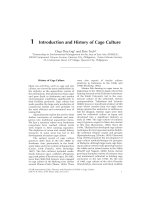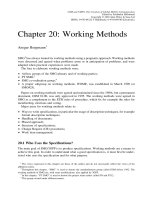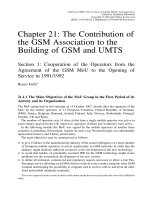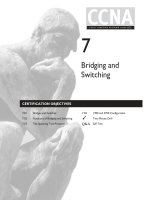Tài liệu Introduction and Planning pptx
Bạn đang xem bản rút gọn của tài liệu. Xem và tải ngay bản đầy đủ của tài liệu tại đây (539.34 KB, 10 trang )
1
1 Introduction and Planning
1.1 Introduction
Today, injection molding is probably the most important method of pro-
cessing plastics in the production of consumer and industrial goods, and is
performed everywhere in the world.
Once the decision has been made to use injection molding for a new product,
a number of difficult choices are ahead which will be addressed later in more
detail:
Number of cavities
Stack design, which is the purely technical aspect of how to mold the pro-
duct. It is important to understand the design of that portion of the mold
that is actually in contact with the plastic (the “stack”), i.e., the cavity, core,
and any other mold components, which determine how the final product
will be shaped and how the plastic will enter the cavity space
Method of ejection, i.e., how the product will be ejected from the mold
What machine should be used?
Automation – will it be required?
With new, possibly difficult shapes, these decisions are usually left to the
ingenuity of a mold designer. More frequently, precedents from earlier molds
are used and reapplied. However, the mold designer must be aware of and
evaluate new ideas, new methods, and developments, which when applied
would lead to better quality, higher productivity, simpler molds, and savings
in the cost of the molded products.
After the design of the basic stack and before proceeding with any mold design,
the mold designer must understand what kind of mold should be selected;
in other words, which features will be most suitable for the application to
achieve the most economic overall manufacturing method for the product.
This means not just to specify the number of cavities that will be required
for the expected output, but also the selection of mold materials and the degree
of sophistication of the mold. Any planned automation, especially in product
handling after molding, can affect the mold layout, particularly spacing and
orientation of the stacks. The mold designer must never lose sight of the
ultimate goal: The cost of the product must be the lowest possible, while still
achieving all specified requirements. The most important information is to
know beforehand the quantities to be molded, a piece of information,
particularly with new products, often very difficult to obtain.
It should also be pointed out that of the total cost of almost all plastic pro-
ducts, the cost of the plastic material alone constitutes the greatest component.
Mold designers must not be stuck in
a comfortable rut
The ultimate goal of a mold is to
produce an acceptable quality
product at the lowest possible cost
Often, the most important informa-
tion is the most difficult to obtain
1281han01.pmd 28.11.2005, 10:471
2
1 Introduction and Planning
The most sophisticated, best designed mold will not lower the cost of the
product by as much as the reduction of just a few percent of the amount of
plastic material, if it could be removed from the product without affecting
its quality or serviceability. Most often, unnecessarily heavy wall thickness
and ribbing affects the cost more than anything else. Chances are that the
lowest weight will be achieved with the highest quality molds.
In my long experience, I have had numerous occasions when the client insisted
on having his way. When I strongly believed it was the wrong thing to do, I
suggested to them to have this mold built somewhere else. Almost all came
back sooner or later for other business, and acknowledged that they should
have listened to me.
The foremost intent of this book is to present various alternatives available
to the mold designer or decision maker when planning a mold for a new
product or planning to increase the productivity for a product for which a
mold exists. It raises many of the questions that must be asked by anybody
who needs a mold built. Some of these “questions” may appear obvious and
not worth mentioning, or their pursuit may be thought a waste of time, but
I like to point out that any input could significantly affect the productivity as
well as the cost of a mold. For an experienced mold designer, the answers for
many of these questions often come automatically, without him or her being
aware of the fact that a decision has been made. But even the most experienced
mold designer can gain important information by systematically investigating
all areas that can affect the design and the complexity of the mold and even
the most experienced designers overlook some obvious facts.
In this book an attempt has been made to explain why certain mold features
should be selected, considering the planned productivity and expected costs.
There will also be occasionally references to other books on this subject, such
as “Mold Engineering” [5] and “Understanding Product Design for Injection
Molding” [1].
Since in many mold shops the mold designer is also involved in estimating
the cost of the mold to be quoted, the book also intends to discuss various
ways of how to estimate mold costs. Properly estimating mold cost is probably
the most difficult part of running a successful mold making operation.
Regardless of how well a shop is equipped with machine tools and other
mold making equipment, and how high the level of experience is of the
machinists and mold technicians (mechanics), if the mold cost is not
adequately quoted it will be impossible to stay in business. We must never
forget that the primary purpose of any business is to make money, and there
is nothing easier than to lose money by poorly estimating and quoting. There
is no magic formula to estimate a mold cost, but good understanding of the
principles will lead to better cost estimates.
We must not forget in dealing with
the customers who require a new
mold that it is not what they want
but what they need
Figure 1.1 Typical mold-making factory
using automated equipment
1281han01.pmd 28.11.2005, 10:472
3
1.2 Oversimplification
In the early 1950s, when I was an R&D engineer at a large electrical manu-
facturer, I had just submitted a request of appropriation for a mold for a new
product when the vice-president of sales stormed into my office, and said:
“Why do you always need so much money for a mold? What is a mold? Isn’t
it just an upper and a lower half?”
This was in the heydays of compression molding, before the injection molding
technology gained importance dramatically. A compression mold was exactly
what the VP implied: a lower half with one or more cavities, and an upper
half with the matching cores (see Fig. 1.2). The plastic was hand-fed into the
lower (open) cavity; there was no or little sophistication with heating (these
molds were processing thermosets and therefore needed to be heated, not
cooled). Often, there was no ejection mechanism at all, or it was relatively
simple.
Of course, what the VP failed to understand was the complexity and accuracy
of the work required to build the various components of these “halves”, the
strength required to resist the high molding forces, the time required for
machining and good polishing, and other features required for even a “simple”
mold. Unfortunately, even today, many years later, this attitude of oversimpli-
fication is frequently encountered when discussing a required mold and its
cost.
Since that time, thermosets (“compression”) molding has become quite
sophisticated, and is using injection molding technology occasionally, but is
still mostly using the vertical machine arrangement, because of the original
loading method of the plastic material by gravity. This was also the time
when injection molding took over the molding market from small beginnings.
But for a number of reasons it soon became more convenient to use horizontal
machines, although today again, some vertical injection molding machines
are used for certain applications. But regardless of the type machine used,
the most important part of the molding system is still the mold.
1.2.1 Definitions
Before continuing, here is a list the various terms used:
Product: an injection molded plastic piece
End product: an assembly, of which the product is a part
User (end user): persons using the product or end product
Customer: the person or company interested in buying the injection mold
Mold maker: the person or company engaged in making injection molds
Mold designer: the person responsible for designing the mold
1.2 Oversimplification
a
b
c
d
e
f
g
h
a Upper platen (stationary or moving)
b Heating platen
c Upper mold half
d Core
e Cavity
f Lower mold half
g Heating platen
h Lower platen (stationary or moving)
Figure 1.2 Schematic of a compression
mold for a plate
1281han01.pmd 28.11.2005, 10:473
4
1 Introduction and Planning
Product designer: the person responsible for designing the product to be
molded
Molder: the person or company engaged in injection molding plastic
products
1.3 Is Injection Molding the Right Choice
for this Product?
Before proceeding, we must ask: “why was injection molding selected for the
job?”
The molder may have a financial or other interest in preferring to have the
product made by injection molding, but we must keep an open mind.
Have alternative methods or product designs been considered or investigated,
employing other manufacturing processes using the same or a similar
materials, or using other materials which may permit a similar end product,
possibly even with better quality, and/or at lower cost?
A few typical examples of possible manufacturing alternatives for injection
molding:
Thermoforming
Foam molding
Coining and die stamping (blanking)
Extrusion blow molding
Machining, forming of sheets
Some other, maybe yet to be developed methods and materials
Another possibility is not to use plastics at all, but rather use:
Paper (cardboard), wood, cloth
Metals (steel, aluminum, etc.)
Injection molding has many advantages, particularly low mass, achievable
accuracy, good strength-to-weight ratio, good appearance and surface
definition, and numerous specific physical properties. But injection molded
products always suffer from the fact that the initial capital outlay for molds
and machines can be very high. But we must never forget that on a per unit
basis, especially whenever large quantities are considered, the contribution
of the cost of the equipment (mold, machine, etc.) to the cost of the product
is small and often almost negligible.
Figure 1.3 Typical injection molded parts
The relatively high capital cost of a
mold is often almost negligible when
evaluated on a per-molded-part
basis
1281han01.pmd 28.11.2005, 10:474
5
1.4 The Injection Molding Machine
We will not discuss the advantages and disadvantages of the various injection
molding machines that are on the market, but rather introduce the reader
who is not too familiar with this industry to the various terms that will be
used from time to time if a subject under discussion will have special reference
to a machine element or feature. The accuracy of molding, and especially
when molding so-called thin-walled products, is very dependent on the
quality of the molding machine, its mechanical rigidity, accuracy of alignment,
parallelism of platens, the quality of its controls, and the state of maintenance.
Every good injection-molding machine consists of these basic elements
1. A rigid base
2. A rigid clamping unit, consisting of two platens, for the mounting of the
mold halves and provisions for guiding the platens (tie bars or ways)
3. Provision for moving the platens, preferably fast, relative to each other,
for opening and closing the mold; the speed of motion is usually
adjustable
4. Provision for clamping, i.e., holding the mold shut against the force of
the injection pressures within the mold (in some machines, provisions 3
and 4 are combined)
5. Provision for ejecting the molded product(s) from the mold
6. Provision to transform the raw plastic (pellets, etc.) into an injectable
melt (the plasticizing unit)
7. Provision for injecting the melt into the mold (in most machines,
provisions 6 and 7 are combined in one unit)
8. Provision for heating the plastic in the plasticizing unit
9. Cycle controls (sequencing logic, timers, etc.) and a command post for
manual operation and for mold setup
10. Heat controls for all heaters in machine and molds. Some machines have
a limited number of heat controls and additional controls could be
required for the molds, especially with larger hot runner systems. This
point must be considered when estimating the mold cost.
11. Safety gates to protect operators and bystanders from all hazards when
operating the machine
12. Mechanical safety drop bar(s) to prevent closing the machine when gates
are open, in case of failures of the other (electric and hydraulic) safety
measures.
13. Provision for cooling water distribution to the mold
14. Provision for compressed air, for auxiliary actions required in the mold
Even the best machine – if poorly
maintained – will not perform as it
should
1.4 The Injection Molding Machine
The mold designer who believes that
the product considered could be
made better by other methods has a
duty to discuss this with the
customer, even if it could mean lost
business, this time
1281han01.pmd 28.11.2005, 10:475
6
1 Introduction and Planning
There are other features available, e.g., for the convenience of quick mold
installation, setting up and operation of the mold and machine; these features
are often offered as options which can be bought with the machine or added
on later.
1.4.1 The Right Machine for the Mold
Often, the mold cost will surpass the cost of the machine. It does not matter
how ell a mold is built if the machine cannot meet the molding requirements
to produce quality products. While considering the purchase of an injection
mold, it is always important to make sure the machine can do the job. Some
of the basic considerations are:
Tie bar spacing
Stroke and shut height
Injection speed (average and peak)
Available injection pressure
Recovery rate capability (throughput)
Platen rigidity (are the platens rigid/robust enough to carry the mold
weight?)
Available clamp tonnage
Platen parallelism
Clamp speed requirements
Shut-off nozzles
Screw design
Accuracy and repeatability of controls
Operator access
Mold protection capability
As the machine and mold act together as a system, it is fair to say that the
system will perform only as well as its weakest component. If an existing
machine is to be used, the machine should match the machine's capability.
The mismatched machine can easily destroy the new mold in a matter of
months, resulting in costly rework.
To determine the right machine, the following information on the mold is
required:
Mold width, length, and height
Opening stroke required (usually 2.5 × part height)
There is no point in buying a
premium priced mold to run it in an
out-dated machine
1281han01.pmd 28.11.2005, 10:476
7
Ejector rod locations
Locating ring size
Part dimensions, including wall thickness
Flow length (length of flow from gate to longest flow path)
Part weight
Runner weight (if cold runner)
Cavitation
Nozzle radius
Material (including color and additives, viscosity)
1.5 The Injection Mold
To the customer or entrepreneur not familiar with the problems of molding
and mold making who wants to make a new product, the price of a mold
may seem to be high, occasionally even outrageous; it is often difficult to
convey that the mold price constitutes only a very small portion of the product
(piece) cost, and depends much on the expected production of the mold.
1.5.1 What Is an Injection Mold?
A (plastics) injection mold is a permanent tool, i.e., a tool that, if properly
designed, constructed, and maintained will have a life expectancy (useful
life) well beyond the time where the product itself becomes obsolete. This
differentiates it from a “one-time use” mold such as a sand-casting mold, as
used in metal foundries. A mold can be used to make products in a virtually
infinite variety of shapes, made from injectable plastics. Common to all molds
is the condition that it must be possible to remove the product after molding,
without the need to destroy the mold (as is the case in sand-castings).
There is an exception to this, the so-called “lost-core molding”: There are
injection molds for intricate products, such as intake manifolds for internal
combustion engines, previously made from cast iron, which have an outside
shape that can be molded with conventional (permanent, “open and close”)
molds but where the intricate inside shape is made from a molded, low melting
point metal composite which is inserted into the mold before injection, and
then ejected together with the molded product; the metal is then removed
by heat at a temperature above the melting point of the insert, but of course
below the melting point of the plastic used for this product; the molded
metal insert is thereby destroyed, but the metal will be reused.
A basic mold consists of two mold halves, with at least one cavity in one
mold half, and a matching core in the other mold half. These two halves
1.5 The Injection Mold
It is important to understand that it
is not the mold cost but the piece
(unit) cost of the product, which is
important
1281han01.pmd 28.11.2005, 10:477
8
1 Introduction and Planning
meet at a parting plane (parting line). As the mold opens – after the injected
plastic (now in the shape of the desired product) is sufficiently cooled and
rigid – the product can be removed by hand or be automatically ejected.
Because injection-molding machines are mostly built with the injection on
the stationary platen side, there is, typically, no built-in ejection mechanism
on this side. If ejection from the injection side should be required – always
the case in stack molds, and occasionally required in single level molds – any
required mechanism must be added to the mold, and occasionally to the
machine; in either case, this adds complexity and increases costs. Only molds
designed for using only air ejection do not require any external ejection
mechanism.
Most products are removed (ejected) from the core. There are also many
molds, which need special provisions to allow the products to be removed
from either the cavity or the core. This is the case with products having severe
undercuts or recesses on the inside and/or the outside of the product, such
as screw threads, holes, ribs or openings in the sides of the product, etc., or
molds for insert molding.
Some of these design features of the product may require moving side cores,
which are either inserts or whole sections of the cavity that move at an angle
which is 90° to the “natural opening path” of the mold. Others may require
special unscrewing mechanisms, either in the core or in the cavity side. The
mold may require split cavities (or “splits”), i.e., the cavity consists of two or
more sections, which are mechanically or hydraulically moved in and out of
position, and then clamped together during injection. In some cases, the
mold may require collapsible cores, or retractable inserts, which are all quite
complicated (and expensive) methods.
Any of the above special features can add considerably to the mold cost when
compared to a simple “up and down” mold where the products can be readily
ejected with the machine ejectors during the mold opening stroke or after
the mold is open, without the need for any of these complicated mold features.
Note that in this book, the term (simple) “up and down” molding is used,
which comes from the earlier vertical molding machines, even though, today,
most general-purpose injection molding machines are horizontal and the
mold opens and closes in a horizontal motion.
Example 1.1
To illustrate how different mold features affect the mold cost, we assume
that a single face mold with air ejection of the products costs X dollars.
A similar mold, but with mechanical ejection, costs about 1.2 times X.
A similar, air- ejected 2-level stack mold will be about 1.8 times X.
An unscrewing mold for a similar size mold and product will cost about
2 times X.
Almost any shape can be molded –
but at what cost?
1281han01.pmd 28.11.2005, 10:478
9
1.5.2 Elements of an Injection Mold
Most readers will expect to see some illustrations (photos or schematics) of
injection molds at this point. However, we must not forget that this is not a
book about mold design, but about the relationship between productivity
and cost of molds, as well as the cost of the products to be made. There will
be, however, a number of photos of molds accompanying the text where
deemed useful.
There are books that show designs of numerous, specific molds but it is
virtually impossible to show every possible configuration that may be
required. It is more important for the designer, and any person requesting a
new mold, to understand that a mold consists essentially of a number of
elements from which to choose for the most appropriate design for the
purpose.
Every injection mold consists of the following basic elements:
1. One or more matching cavities and cores, defining the cavity space(s)
(today, there are molds with anywhere between 1 and 144 cavities).
2. A method, or element, to duct the (hot) plastic from the machine nozzle
to the cavity spaces:
There is a choice between
– Cold runners (2-plate or 3-plate systems)
– Hot runners (various systems)
– Insulated runners, through shooting
– Sprue gating (cold or hot)
3. Provision to evacuate air from the mold (venting):
There is a choice between
– Natural venting
– Vacuum venting
4. Provision to cool the injected hot plastic sufficiently to allow ejection of
the molded product
5. Provision to eject the molded product:
There is a choice between
– Manual product removal
– Ejector pins and sleeves
– Stripper s (stripper rings or bars)
– Air ejection
– Random ejection
– Various methods of in-mold product removal methods
– Robotic product removal
6. Provision to attach (interface) the mold to the molding machine:
There are several methods to consider
– Mold is for one machine only
1.5 The Injection Mold
Product quality, productivity, and
mold cost depend heavily on the
proper selection of the runner
system
1281han01.pmd 28.11.2005, 10:479
10
1 Introduction and Planning
– Mold to be used on several, different machines
– Quick mold change methods (various designs)
7. Method of alignments of cavities and cores:
There are several methods to consider
– No alignment feature provided in the mold
– Leader pins and bushings (2, 3, or 4)
– Leader pins and bushings between individual cavities and cores
– Taper fits between individual cavities and cores
– Taper fits between plates
– Any combination of the above
8. Any number of (mold) plates to provide the necessary for carrying and
backing the above elements
But molds could have additional features, which will also be discussed in the
following. Each of these features can add (often considerable) costs to the
mold but in many cases can increase the productivity of the mold and reduce
the cost of the product. They may or may not all be necessary and must be
carefully considered when deciding on the type of mold most suitable (and
most economical) for the job on hand.
Features such as serviceability of the mold may affect the mold cost; for
example, the access to hot runners for cleaning plugged gates or making
minor repairs, such as changing a nozzle, a burned-out heater, or a faulty
thermocouple at a hot runner drop will cost more in the initial mold, but
this will be easily recouped by reducing the down time necessary to accom-
plish such repairs. By designing easy access to these components in the
machine (without the need to remove the whole mold, or part of it, to the
bench), such repairs can be made in less than an hour, instead of taking
several hours. This work can also be done by the mold setup staff rather than
getting the (expensive) mold makers involved.
Another area where valuable maintenance time can be saved is to design and
provide easy access from the parting line to screws holding modular mold
parts to their mounting plates, while the mold is in the machine.
On the other hand, in my experience, many molds, particularly molds for
lower production quantities, have been vastly over-designed and much money
has been wasted.
The main purpose of this book is to discuss the various elements or features
listed above and to facilitate the selection and the decision making. Defining
what is really required considering the shape and complexity of the product
and the required production quantities will enhance mold productivity. In
addition, the book should facilitate investigating if, even minor, changes to
the product shape could lower the mold cost and improve the productivity
of the mold or the whole system.
Figure 1.4 Mold maintenance in the press
is important. Here, the operator is changing
a nozzle tip while the mold is in the press
(Courtesy: Husky)
Easy serviceability of the mold is
important but often overlooked. It
adds some mold cost, but saves
much more in future servicing costs
and downtime
Even minor changes to the part can
dramatically lower or increase mold
costs
1281han01.pmd 28.11.2005, 10:4710









